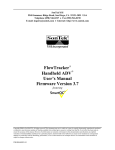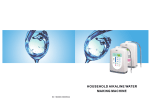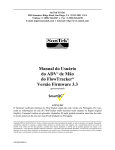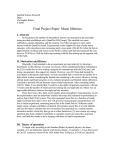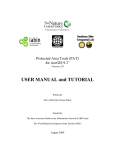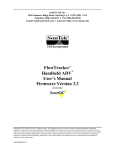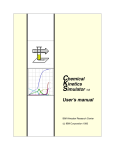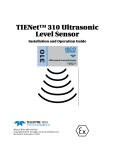Download Answer - Shippensburg University
Transcript
A Hydrologic Study of the Middle Spring Creek near Shippensburg, Pennsylvania Keri Simmons M.S. Practical Exam October 26, 2012 Table of Contents Abstract……………………………………………………………………………………………………………….1 Introduction………………………………………………………………………………………………………..1 Literature Review.……………………………………………………………………………………………….2 Study Area.…………………………………………………………………………………………………2 Groundwater and Surface Water Interaction….………………………………….………....4 Karst Hydrology………………………………………………………………………………………….3 Equipment……………………………………………………………………………………………….....8 Acoustic Doppler Flow Tracker.………………………………………………..….……8 Pygmy Meter……...…………………………………………………………………………….10 Methods……………………………………………………………………………………………………………….10 Pygmy Meter………………………………………………………………………………………….......12 FlowTracker..……………………………………………………………………………………………..13 Results…………………………………………………………………………………………………………….......14 Pygmy Meter….…..………………………………………………………………………………………14 FlowTracker………………………………………………………………………………………………16 Discussion of Results ………………………………………………………………………………………....16 Pygmy Meter vs. FlowTracker..……………………………………………………………...……17 Stream Characteristics………………………………………………………………………………..18 Location A………………………………………………………………………………….........19 Location B ……………………………………………………………………………………….20 Hydrogeological Explanation ………………………………………………………………………21 Conclusion …………………………………………………………………………………………………………..22 References Cited...………………………………………………………………………………………………..24 Figures and Tables Figure 1…………………………………………………………………………………………………………………4 Figure 2…………………………………………………………………………………………………………………7 Figure 3…………………………………………………………………………………………………………….......9 Figure 4…………………………………………………………………………………………………………….......9 Figure 5…………………………………………………………………………………………………………….....11 Figure 6…………………………………………………………………………………………………………….....11 Table 1…………………………………………………………………………………………………………………13 Table 2…………………………………………………………………………………………………………………14 Table 3…………………………………………………………………………………………………………….......14 Table 4….……………………………………………………………………………………………………………..16 Appendices Appendix A: FlowTracker Results from Location A……………………………………………….26 Appendix B: FlowTracker Results from Location B……………………………………………….30 1 Abstract This study was conducted at two different locations along Middle Spring Creek to determine if the stream segment between the measurement points was a losing or gaining segment. At the time of the study, Middle Spring Creek was generally a gaining system. Measurements were taken using a Pygmy Meter and a state-of-the-art Acoustic Doppler FlowTracker. The Pygmy Meter was used at only one site to compare its results to those of the Acoustic Doppler FlowTracker. The FlowTracker measurements appeared to be more accurate than those of the Pygmy Meter. The FlowTracker provides quality check information to assure the accuracy of its readings. Given that the stream was a gaining stream at the time the study was conducted, it can be said that baseflow was contributing to the flow of the stream. The geology of the Cumberland Valley allows for a vast underground network of stream channels. These underground channels are a recharging mechanism for the two main streams that drain the valley; Conodoguinet and Yellow Breeches Creeks. The few surface streams in the valley allude to the theory that much of the water in the area must flow underground. Introduction It was once believed that there was no connection between surface water and groundwater. If surface water was lost to the subsurface, it was thought to never return to the surface. However, this is no longer the case. It is now known that surface water and ground water are constantly interacting. Depending the hydrgeologic conditions, aquifers and streams will feed each other. This is where the idea of gaining and losing streams arise. This study was conducted by collecting discharge data at Middle Spring Creek near Shippensburg, Pennsylvania. The discharge data was collected at two locations, roughly ---miles apart, enclosing a middle segment. Two pieces of equipment; a Pygmy meter and the state-of-the-art Acoustic Doppler Flow Tracker, were used for the discharge data collection. Both pieces of equipment are used by the U.S. Geologic Survey and are considered acceptable methods of measuring discharge (Rehmel, 2007) 2 This study focused on answering the following questions: Is Middle Spring Creek a gaining or losing stream between the two measurement locations? What hydrogeological conditions could affect that status of gaining or losing? Shippensburg is located in a karst terrain, which can complicate the hydrogeological conditions. Literature Review Study Area Shippensburg is located in south-central Pennsylvania in the Cumberland Valley between South Mountain, to the south, and Blue Mountain, to the north. South Mountain is part of the Blue Ridge Physiographic Province, and Blue Mountain is part of the Ridge and Valley Physiographic Province. In the Ridge and Valley Physiographic Province, the bedrock has been folded and faulted due to tectonic activity during the formation of Pangaea. The structural trend of the area is to the east-northeast. Tectonic activity caused the carbonate bedrock to fracture. Due to the rate at which carbonate rocks dissolve, these fractures enlarge from the flow of infiltrating water. Together with the dissolution action of water, karst features such as sinkholes, caves, or solution cavities are formed and become underground conduits for water to flow. Karst features that can be seen in the valley are sinkholes, closed depressions, sinking springs, and swallow holes (Chichester, 1996). A colluvium wedge, of thickness up to 137 meters thick, exists at the border of South Mountain (Chichester, 2006). This colluvium extends and thins to the middle of the Cumberland Valley allowing carbonate outcrops to appear. This colluvium consists of resistant quartzite material from which South Mountain is derived. 3 There are two main surface streams that drain the valley: the Conodoguinet Creek and Yellow Breeches Creek (Hurd et. al., 2010). The Conodoguinet runs along the base of Blue Mountain and Yellow Breeches runs along the base of South Mountain. The Conodoguinet Creek drains most of the Cumberland Valley before flowing to the Susquehanna River (Becher and Root, 1981). The Middle Spring Creek and Burd Run system, located in the southwestern part of the Cumberland County, is the only surface water system that connects the headwaters on South Mountain to the Conodoguinet Creek (Chichester, 1996) (Figure 1). The climate of south-central Pennsylvania is classified as humid-continental (Chichester, 1996). The average daily temperature in October is 55 degrees Fahrenheit. The average rainfall in October is 2.99 inches (Shippensburg University Weather Page). The average daily temperature, for October 2012, was 56 degrees and the amount of precipitation was 1.82 inches. On the day the measurements were taken, Shippensburg was falling short of the average precipitation of 3.01 inches, which is based on precipitation data collection since 1932. The two locations at which the measurements were taken can be seen in Figure 1. Location A, was just downstream of the confluence of Burd Run and Middle Spring Creek. Location B, was approximately 2 miles downstream, and a much smaller stream feeds into it about 1.3 miles downstream from Location A. 4 Figure 1. Locations A and B of study along Middle Spring Creek. Also shown are the tributaries to Middle Spring Creek: Unknown Stream and Burd Run. Groundwater and Surface Water Interaction Until recently, the interaction between groundwater and surface water was not a much talked-about subject. However, the subject has become more prominent owing to practical observations. For example, contaminants that enter an aquifer have resurfaced in a nearby stream and vice versa. Thus, surface and groundwater systems are increasingly studied from an integrated approach. Hydraulic interactions between surface and groundwater occur by subsurface lateral flow through the unsaturated soil 5 and by infiltration into or exfiltration from the saturated zones (Sophocleous, 2002). In karst terrains, the interactions between surface water and groundwater can occur through fracture and/or solution channels. In order to better understand groundwater and surface water interactions, one must understand the effects of the entire hydrogeologic environment (Sophocleous, 2002). For example, groundwater flow is affected by climate, geology, and topography. Climate affects groundwater through precipitation, a major source of recharge, and evapotranspiration (a major loss). Groundwater is also affected by geology due to the various properties of the host rocks such as the hydraulic conductivity and porosity. Similarly, topography controls groundwater flow directions similar to its control on surface streams due to slope changes. These interactions were not completely accepted until the 1960’s when water management started to become an issue. More broadly, groundwater-surface water interaction is best exemplified in the context of whether a surface water body recharges an aquifer, or vise versa. All rocks have the ability to hold and transmit water through the pore spaces that exist between mineral grains (White, 1988). Rock formations capable of holding large amounts of water are known as aquifers. Water infiltrates through the soil and into the rock formations below under the influence of gravity. Once it reaches the water table, the area that separates the air filled pore spaces from the water filled pore spaces it ceases downward movement. If a permeable zone of rock allows the movement of water beneath an impermeable zone, this is known as a confined aquifer. The water located in this area is not known as water table because it does not communicate freely with the surface. Rather, it is known as a piezometric surface. This refers to the amount of 6 pressure head beneath the confining layer. The water in an aquifer moves under the influence of hydraulic gradient from sources of recharge to areas of discharge. The hydraulic gradient of the water table is highest at areas of recharge and lowest at areas of discharge (White, 1988). This hydraulic gradient determines whether or not the surface stream will recharge an aquifer or the surface stream will be recharged by the aquifer. If the gradient of the aquifer is higher than that of the stream, the aquifer will feed the stream. When this occurs, the stream is known as an effluent (gaining) stream. If the gradient of the stream is higher than that of the aquifer, the stream will feed the aquifer. This is type of stream would be an influent (losing) stream. The flow of water that recharges and maintains flow of a stream, between precipitation events, is known as baseflow (Sophocleus, 2002). For many streams and springs in the Cumberland Valley area, this baseflow is the primary source of recharge. The hydrology of the Cumberland Valley varies greatly due to the carbonate bedrock underlying the valley. The same hydrologic fundamentals, as discussed above, are still at work but the aquifers can vary greatly. Karst Hydrology Aquifers located in carbonate bedrock are known as carbonate aquifers. Carbonate aquifers can vary greatly in their properties. Carbonate aquifers vary from other aquifers because of the integrated system of pipe-like conduits that transport water in a localized area. Carbonate bedrock can dissolve quite rapidly in an environment where water is readily available. This dissolution of calcite in the bedrock can form subsurface pathways for water to travel. In karst terrains, groundwater is very 7 abundant and can be found in caves or conduits. Sinkholes and sinking springs can be a direct recharging mechanism for groundwater. Typically in an area of karst terrain, there is a lack of surface streams. This lack of surface streams is due to the valley losing its water to developing underground drainage system (White, 1988). As the underground drainage system develops, more stream water along with the groundwater that would have recharged the stream during dry times diverts to the subsurface. Figure 2 shows the lack of surface streams in the Cumberland Valley. This scarcity of surface streams in the Cumberland Valley is sure sign that water flows primarily underground. Figure 2. This map shows the paucity surface streams in the Cumberland Valley, Cumberland County between Conodoguinet Creek and Yellow Breeches Creek (Hurd et al., 2010). 8 A study conducted by Hurd et al. (2010) concluded that water entering the groundwater system parallels the valley topography and geologic strike from west and south and discharges the groundwater system at springs. There are several limestone springs located throughout the Cumberland Valley. In general, springs may come to the surface and form a surface stream, or springs may enter an existing stream at the streambed. It is not clear if any springs emerge beneath Middle Spring Creek, but its flow through a karst terrain makes this a possibility. Thus, by measuring discharge just below the confluence of Middle Spring Creek and Burd Run Creek, and another point two miles further downstream, we might get an indication about the status of the enclosed segment (i.e. whether it is a gaining or losing segment). Equipment Used Acoustic Doppler Flow Tracker The FlowTracker uses acoustic Doppler velocimeter (ADV) technology. The basis behind the FlowTracker ADV is the Doppler Shift (SonTek/YSI, 2009). The Doppler principle states that if a source of sound is moving relative to the receiver, the frequency of the sound at the receiver is shifted from the transmitter frequency. The FlowTracker operates at an acoustic frequency of 10Mhz and measures the change in frequency of sound reflected off the particles (organisms, bubbles, sediment) in the flow (Rehmel, 2007). Unlike mechanical meters that use the motion of water to turn, which directly measures the velocity of water, the FlowTracker measures the velocity of particles suspended in the flow. The quality of measurement is dependent on the existence of particles in the water. 9 The components of the Flow Tracker are the handheld controller and the Flow Tracker probe. Both components are attached to a top-setting SonTek wading rod (Figure 3). The Flow Tracker probe does not consist of any moving parts. The probe contains the acoustics elements to measure the velocity of the water. The center of the probe is orientated so that is parallel to the flow (Figure 4). Figure 3. From left to right, Flow Tracker ADV handheld unit and the Flow Tracker probe attached the SonTek top-setting wading rod (SonTek/YSI, 2009). Figure 4. The picture shows the center of the probe should be parallel to the flow of the stream. It should remain perpendicular to the tag line (SonTek/YSI, 2009). 10 Pygmy Meter The Pygmy current meter is a discharge-measuring piece of equipment and is used by the U.S. Geological Survey for discharge measurements. A Pygmy meter has a rotating meter attached to a top-setting wading rod. Headphones are attached in order to hear the clicks that represent one revolution of the meter. The clicks are heard every time an electrical circuit is completed. The Pygmy meter differs from the Flow Tracker in that it requires two people to be involved. One person must keep time and another person must count the clicks. Manual calculations are needed in order to determine the discharge at each station. The Flow Tracker counts the time needed to record the velocity and calculates velocity instantly. Methods The discharge measurements were performed at two locations along Middle Spring Creek (refer to Figure 1) to determine if it was a gaining or losing stream between the two locations. At location A (Figure 3), the discharge was measured using both the Pygmy meter and the FlowTracker ADV for comparative purposes. The FlowTracker was the instrument of choice in this study. It was used alongside the Pygmy current meter in order to compare and contrast the two instruments. At location B (Figure 4), only the FlowTracker was used to calculate discharge. Each location was examined for ideal stream characteristics when calculating stream discharge. Ideal characteristics include a relatively smooth streambed free of debris that could cause eddies, pooling water, or turbulence. 11 Figure 5. Location A, using the Pygmy meter. Figure 6. Location B, using the FlowTracker. 12 Pygmy Meter Upon locating an ideal cross-section of the stream channel to be measured, a measuring tape was anchored to both edges of the stream channel. The total width of the channel was determined. The width was then divided into smaller cross-sections for discharge measurements following the guidelines set up by the U.S. Environmental Protection, but was based on USGS standards of practice (Forrest). This procedure was used at both locations (A and B). The Pygmy meter was then set up and tested to begin discharge measurements. The meter was attached to the wadding rod and a test spin was performed after lubricating the meter. The meter surpassed 60 seconds during the test spin. The headphones were then attached to the wadding rod. Once the meter and site setup were complete, measurements were taken for 18 cross-sections across the channel. The meter was adjusted based on the sixty percent depth rule for measuring discharge. The 60 percent rule is most commonly used and is the method used by the U.S. Geological Survey. The sixty-percent rule is used when the water depth is 2.5 feet or less. In general, water velocity at 60 percent of the depth is a good average velocity of the water column. At each station, revolutions (R), heard as clicks through the headphones, were counted for 40 seconds and recorded. These were used in the formula below to determine cross-sectional velocities (USGS, 1999): Velocity (V)= 0.0312+0.9604R Where: V= velocity (ft/sec) R= 13 The calculated velocities were then used to determine discharge for each crosssection using the following equation (USGS, 2012): Q=VA Where: Q= Discharge V=Velocity A=Area The total discharge at the location was determined by summing all crosssectional discharges. FlowTracker After completing measurements with the Pygmy Meter at location A, the FlowTracker was then setup for use to determine discharge. The same cross-sections used for the Pygmy Meter were used for the FlowTracker. At location B, the site was set up according to the method above but 24 cross-sections were taken due to the greater width of the stream at this point. The first step in using the FlowTracker was to put the wading rod together and then mount the Handheld Unit to the wading rod. A name was given to the file, site, and operator before beginning measurements. The default mode (the desired mode for this research) for collecting measurements was discharge mode, which uses the midsection discharge equation. This equation is the same equation used for the Pygmy Meter described above. The 60 percent of depth rule was chosen by using the “Method +” button. The FlowTracker then asked to run a Quality Check Test. This was done before beginning measurements at both sites to assure the equipment was working properly. 14 To begin measurements, the meter was placed at the starting edge of the stream. The first screen that appeared was for the starting edge. Depth of water and location (distance) were the only items entered at this station. The “next station” button was then pressed and the depth and location information was entered before pressing “Measure”. After 40 seconds, the FlowTracker calculated a velocity for that particular station. The station could be accepted or repeated if desired. Once accepted, FlowTracker Handheld Device moved to the next station and this process was repeated until the other edge of the channel was reached. Once at the other end of channel, the “end station” button was pressed. This let the computer know the section was completed so the handheld unit could calculate the discharge. In order to calculate the total discharge, the “calculate disch.” button was pressed and a total discharge was displayed instantly. An advantage of using the Flow Tracker over the Pygmy is there is no room for human error when calculating the discharge of the stream. In order to interpret the data, the FlowTracker software was used. This software was extremely user friendly and allowed for quick interpretation of the data. Once the handheld device was connected to a computer, the software downloaded the data and gave the results in a very complete and organized fashion. The data were then interpreted and notes for future use were made. Results Pygmy Meter The results for measurements taken with the Pygmy Meter are given in Table 1. The total width of the stream was 17 feet. Measurements were taken in one-foot 15 increments along the cross section, except the first measure, which was taken at 0.5 feet in order to avoid vegetation along the edge of the stream. The cross-sections of the streambed were relatively flat, requiring no variation in cross-section widths. The results showed total discharge of 15.92 ft3/s. The Pygmy Meter was used at Location A only in order to compare the results of the meter to those of the FlowTracker. Stage (ft) 1.02 1.2 1.1 1.25 1.2 1.4 1.6 1.5 1.5 1.55 1.7 1.6 1.65 1.45 1.55 1.6 1.5 1.4 Width (ft) 2 Area (ft ) 0.5 1 1 1 1 1 1 1 1 1 1 1 1 1 1 1 1 1 0.51 1.2 1.1 1.25 1.2 1.4 1.6 1.5 1.5 1.55 1.7 1.6 1.65 1.45 1.55 1.6 1.5 1.4 No. of Revs. Time (s) 1 1 4 6 10 14 3 21 24 27 50 41 68 54 38 27 12 7 40 40 40 40 40 40 40 40 40 40 40 40 40 40 40 40 40 40 R 0.025 0.025 0.1 0.15 0.25 0.35 0.075 0.525 0.6 0.675 1.25 1.025 1.7 1.35 0.95 0.675 0.3 0.175 Velocity (ft/s) 0.06 0.06 0.13 0.18 0.27 0.37 0.10 0.54 0.61 0.68 1.23 1.02 1.66 1.33 0.94 0.68 0.32 0.20 Subsection discharge (ft3/s) 0.028 0.066 0.140 0.219 0.326 0.514 0.165 0.803 0.911 1.053 2.094 1.625 2.745 1.925 1.463 1.087 0.479 0.279 Total Discharge Table 1. Results from the Pygmy Meter showing a total discharge of 15.92 ft3/s Subsection discharges were calculated using Q=VA; where, V= No. of Revolutions divided by time in seconds. 15.92 16 FlowTracker At location A, the FlowTracker calculated a total discharge of 13.25 ft3/s (Table 2), and at location B the FlowTracker calculated a discharge of 15.66ft3/s (Table3). However, the FlowTracker provided far more answers than total discharge. For example, it provided statistics behind each calculated discharge in order to better analyze the method in which the discharge was collected. A full analysis of each location is provided in Appendix A and Appendix B, respectively. Table 2. Total Discharge results from the FlowTracker at Location A. Table3. Total discharge results from the FlowTracker at Location B. Discussion of Results The results showed three different calculated discharges. The Pygmy meter calculated 15.92 ft3/s at location A. The FlowTracker calculated a discharge of 13.25ft3/s at location A and a discharge of 15.66 ft3/s at location B. Topics to be discussed in this section are: the comparisons between the Pygmy Meter and the FlowTracker at location A; a comparison of the results given by the FlowTracker at both locations; a 17 hydrogeological explanation as to why the discharges calculated by the FlowTracker are different. Pygmy Meter vs. FlowTracker The discharge at location A was considerably different between the Pygmy Meter and the FlowTracker (Table 4) measurements. The total discharge result from the Pygmy Meter was higher than that of the FlowTracker by 2.67 ft3/s. The results of the Pygmy Meter may be higher for a number of reasons. Revolutions are counted manually and recorded when using the Pygmy meter. Those revolutions are then converted into a measurement that can be used. The only items taken into account when measuring discharge, with a Pygmy Meter, are the revolution count and the width and depth of the station. There is ample room for human error when using the Pygmy Meter (e.g. incorrect calculations, timing errors, and counting errors). The FlowTracker, on the other hand, records a variety of quality control data to ensure quality of the velocity data. It records standard error of velocity, signal to noise ratio (SNR), spike filtering, flow angle, and boundary adjustment with each measurement. SNR is the most important because it measures the strength of the acoustic reflection from particles in the water. As stated earlier, the standard error of velocity is the direct measure of the accuracy of velocity data. The FlowTracker removes spikes in the data automatically. Flow angle is the direction of the measured velocity relative to the FlowTracker x-axis. Boundary adjustment evaluates the measurement environment for interference of underwater obstacles. 18 Each method has its advantages over the other. The Pygmy meter is much more simple to set-up in the field, but the results given by the FlowTracker appear to be more accurate and certainly less time consuming to obtain. The Pygmy meter does not give warning messages when trying to calculate measurements. Although warning messages received from the FlowTracker can be a nuisance, the warnings let the reader know that something may not be completely accurate for the measurement. The Pygmy Meter is much easier to use in turbulent or slow moving waters for this reason, however, it may not be as accurate. Also, the results from the FlowTracker are laid out in a very organized format. It provides an entire table of the results for each subsection, discharge uncertainty, graphs that show discharge, velocity, and depth, and a summary. The results from the quality control test are also shown. Method Pygmy Meter FlowTracker Total Discharge (ft3/s) 15.92 13.25 15.66 Location A A B Table 4. Results from the Pygmy Meter and FlowTracker at locations A and B. Stream Characteristics The stream characteristics were much different at locations A and B. Location A had some significantly turbulent water and the streambed was not an ideal surface. The streambed was not as flat as one would like and contained patches of underwater vegetation. The stretch of the stream accessible for easy access contained heavy vegetation along the edges and a rocky bottom. The water was flowing at varied rates 19 across the channel. After examining the channel, Location A was the most ideal location because it was far enough away from a bridge, just upstream from the place measurement, and downstream the water appeared to hardly be moving before becoming rather turbid. The stream channel at this location was not as ideal as the stream at location B. Location B appeared to be the most ideal location for measuring discharge. The streambed was flat, it did not contain any rocks that could disrupt the flow, and the flow appeared to be consistent over the particular cross section. Location A Due to the nature of the stream at location A, the results had an uncertainty statistic of 9.5% (Appendix A). There were some negative flow calculations at this location. Measurements were repeated 3 times upon receiving a negative velocity and the velocity remained negative. These negative flows were near the edge of stream. The water seemed to pool slightly along the edges of the stream due to high amounts of vegetation. This negative velocity may have been due to slack water being stirred up due to human activity upon entering the water. However, these negative values do not affect the overall discharge value enough to cause concern. The measurement results table contains several stations (indicated as St) in italics. This means there was a warning upon completion of the measurement at that station. The measurements were repeated two or three times, all of which resulted in a warning. The most common warning was the “High Angle of Velocity” warning. The angle is the direction of the measured velocity relative to the FlowTracker x-axis. The ideal angle is less than 20 degrees. As stated earlier, this streambed was not flat and 20 the water contained some turbulent sections. The high angle could have been due to the water, upstream from the FlowTracker, being routed around a rock or some other underwater obstruction. Another warning that appeared in this section was “High Standard of Error”. This is a direct measure of the accuracy of the velocity data. It is typically 0.03ft/s but can be higher in turbulent water (SonTek/YSI, 2009). Looking at these results, rather than keeping equal spacing between the stations, more stations should have been added where the water was moving the fastest. But given how much information is available when using the FlowTracker, it is helpful to see the results represented in an accurate and organized manner. Even where the water was not thought to be moving so fast, the graph shows exactly what percentage of the total discharge the station has. The FlowTracker also gives a warning when the percent of the total discharge is too high. This was not a warning received upon completing the measurements. Therefore, the percent of the total discharge must not have been a cause for major concern at this location. Location B The stream at location B was quite ideal for measuring discharge. The uncertainty statistic was only 2.2% (Appendix B). There was a large amount of vegetation along the edges of the stream at this location as well. However, at this location, there did not appear to be any slack water. The measurement results table (Appendix B) shows one station that received a warning message. The warning at this station was a “high velocity angle” warning. The angle was 20 degrees and it was due to a mound of sand and vegetation growth upstream from the FlowTracker. Overall, location B was a more ideal location for discharge measurements. 21 Hydrogeological Explanation Based on the image acquired from Google Earth, Inc. (2012), there appears to be a small stream that flows into Middle Spring Creek downstream from location A. Based on USGS topographic paper maps, it is an intermittent stream; meaning it flows occasionally or seasonally. An intermittent stream occurs if the there is a lack of precipitation and evapotranspiration is greater than that of precipitation. If the stream was in fact a tributary to Middle Spring Creek, the title of gaining or losing stream cannot apply to this study. However, if this stream was dry at the time of the study, it would not have been adding any water to Middle Spring Creek and this would mean Middle Spring Creek was a gaining a stream at the time the study was conducted. Middle Spring Creek can be considered a gaining stream if, and only if, it is gaining water from only groundwater. For the sake of this study, it is going to be assumed the unknown stream was dry at the time of the study, which would mean Middle Spring Creek was a gaining stream. Middle Spring Creek’s status of gaining stream between locations A & B means the creek is being recharged solely by groundwater. This means at this particular location, the hydraulic gradient of aquifer is greater than that of Middle Spring Creek. Given the topography around the Middle Spring Creek/Burd Run system, water should be flowing towards those two surface streams. Most likely, the groundwater west of Middle Spring Creek between locations A and B is flowing along the strike and recharging Middle 22 Spring Creek through underwater springs. It is much easier for groundwater to flow into a stream than flow under one. Further investigation should be done in order to determine when the unknown stream contributes to Middle Spring Creek. Due to the karstic nature of the Cumberland Valley, it would not be unexpected if the unknown stream were dry at the time of the study. A dry stream would indicate water is being lost to the groundwater network. Rather than the water flowing in the surface stream, it is flowing as groundwater and recharging Middle Spring Creek in the segment between A and B. The strike of the valley is east-northeast. Groundwater will flow in the direction where it will receive the path of least resistance. The path of least resistance is to flow along the strike rather than perpendicular to it. The vast development of the groundwater network throughout the valley is due to the constant downward movement of water. Carbonate bedrock dissolves easily with this downward flowing water and creates paths through which water can flow with ease. The water then flows underground along the strike, which explains the lack of surface streams throughout the Cumberland Valley. Conclusion The FlowTracker measured a higher discharge at location B than location A. The FlowTracker, based on its quality check parameters, appeared to be more accurate than the Pygmy Meter. There is far less room for human error when using the Flow Tracker than the Pygmy meter. The Flow Tracker is also less time consuming as it 23 calculates discharge automatically at the end of the cross section. It then gives detailed results to better interpret the data. There is an intermittent stream that feeds into Middle Spring Creek between locations A and B. The discharge between these two points could be different due to the flow of the tributary. However, it is unknown if this stream was flowing or if it was dry at the time of the study. Middle Spring Creek based on the discharge measurements calculated by the FlowTracker, is a gaining stream. This means that the stream is being recharged by groundwater. Groundwater flow in the Shippensburg area is more abundant than the flow of surface water. The Cumberland Valley lacks surface streams; therefore, the water is flowing underground. The Middle Spring Creek/Burd Run system is the only surface water connection between the waters of South Mountain and Conodoguinet Creek. The geologic strike of the Cumberland Valley is west to east and is the path of least resistance for groundwater. The groundwater network is vast and the paths are unknown. The groundwater is continuously feeding the surface streams in the area, especially in times when precipitation is lacking. 24 References Cited Becher, A.E. and Root, S.I., 1981, Groundwater and Geology of the Cumberland Valley, Cumberland County, Pennsylvania: Pennsylvania Geological Survey, 4th ser., Water Resources Report 50, 95p. Chichester, D.C., 1996, Hydrogeology of, and Stimulation of Ground-water Flow in, a Mantled Carbonate-rock System, Cumberland Valley, Pennsylvania: U.S. Geological Survey Water-Resources Investigations Report 94-4090, 39p. Forrest, J., Standard Operating Procedure for Streamflow Measurement, U.S. Environmental Protection Agency, 2p. Hurd, T.M., Brookhart-Rebert, A., Feeney, T.P., Otz, M.H., Otz, I., 2010, Fast, Regional Conduit Flow to an Exceptional-Value Spring-Fed Creek: Implications for SourceWater Protection in Mantled Karst of South-Central Pennsylvania. Journal of Cave and Karst Studies, v. 72, no. 3, p. 129-136. Rehmel, M., 2007, Application of Acoustic Doppler Velocimeters for Streamflow Measurments. Journal of Hydraulic Engineering, v. 133, no. 12, p. 1433-1438. Shippensburg University Weather Page, Climatology: http://webspace.ship.edu/weather(accessed October 2012) 25 SonTeck/YSI, 2009, FlowTracker Handheld ADV User’s Manual Firmware Version 3.7 featuring Smart QC, 32p. Sophocleous, M., 2002, Interactions between Groundwater and Surface water: The State of Science. Hydrogeology Journal, v. 10, p. 52-67. United States Geological Survey, 1999, Standard Rating Table No.2 for Pygmy Current Meter: http://water.usgs.gov/osw/pubs/pygmytable.pdf (accessed November 2012) United States Geological Survey, 2012, How Streamflow is Measured Part 2: The discharge measurement: http://ga.water.usgs.gov/edu/streamflow2.html (Accessed November 2012) White, W., 1988, Geomorphology and Hydrology of Karst Terrains: New York, Oxford University Press, 464 p. 26 Appendix A-Results from Location A 27 28 29 30 Appendix B- Results from Location B 31 32





































